|
The Walking
Buddha
The
Sukhothai walking Buddha potrayed in the round marks the peak of Sukhothai
artistry. The walking Buddha had been depicted in murals in Sri Lanka and
India but never in sculpture. It was first depicted in sculpture in Thailand.
The style is graceful and languid, with an expression of bliss and an enigmatic
smile. The smooth flowing lines and the flexed posture of the idealized
figure is also quite remarkable.
|
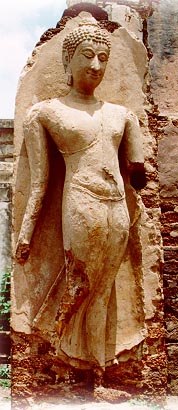
|

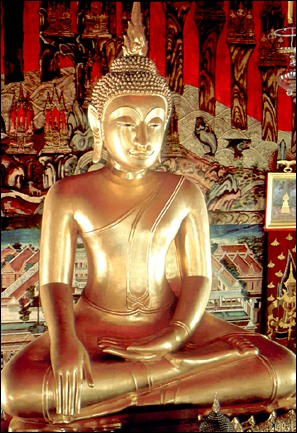
|
The Sukhothai
Buddha
The
Sukhothai Buddha image, particularly when cast in bronze, is regarded as
the most beautiful in all Thai art. Depicted mostly in the Bhumisparsa
mudra, the images are not meant to be realistic. Rather, they emphasize
the Buddha's supernatural qualities. Characteristics of Sukhothai Buddhas
include an oval face, hooked nose, arched eyebrows, small curls on the
head, a serene smiling expression, broad shoulders and slim waist. The
head is crowned by a tall flame motif representing the flame of knowledge.
Steve Van Beek wrote "Sukhothai sculpture suggests a figure in the process
of dematerializing, half way between solid and vapour. He doesn't walk
so much as float. He doesn't sit, he levitates, and belies his masculine
nature which should be hard and inflexible. Even his diaphanous robes...potray
a Buddha who has already shed the trappings of this world."
|

|
The Sukhothai
Viharn
Though
no Sukhothai-period viharn exists today in their pure form, this Sukhothai
viharn at Muang Boran has been reconstructed from the evidence of records.
As seen in the photograph, the windows have narrow openings. Such windows
were of Khmer origin and contributed to the darkness of the interior. The
two rows of columns are to draw the worshipper's eyes towards the main
Buddha image. Columns surmounted lotus-bud decorations were common in Sukhothai
structures.
|

|

|
King Ramkhamhaeng
King
Ramkhamhaeng was one of the greatest kings of Sukhothai. His name means
"Rama the Brave". At the time of his accession to the throne, the Sukhothai
Kingdom was quite small, consisting only of the city and the surrounding
areas but by the end of his reign, his kingdom stretched from Luang Prabang
in the east to the southern peninsula. He is often potrayed as an absolute
monarch but one who ruled with justice and magnanimity. He built up an
alliance with King Mengrai of Lanna and King Ngam Muang of Phayao. They
agreed not to transgress, but instead to protect each others' borders against
common enemies. King Ramkhamhaeng was also credited with the invention
of the Thai script, which he achieved by systematizing the Khmer alphabet
with Thai words.
|
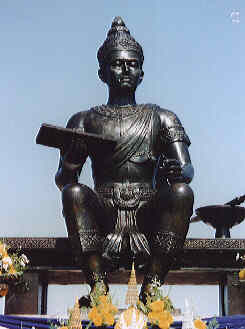
|

The
Ramkhamhaeng Inscription
|
"This
Muang Sukhothai is good. In the water, there is fish. In the fields, there
is rice. The lord of the realm does not levy toll on his subjects for travelling
the roads; The lead their cattle to trade or ride their horses to sell;
whoever wants to trade in elephants does so; whoever wants to trade in
horses does so; whoever wants to trade in silver and gold does so. When
any commoner or man of rank dies, his estate-his elephants, wives, children,
granaries, rice, retainers and groves of areca and betel-is left in its
entirety to his son.........When the King sees someone's rice, he does
not covet it; When he sees someone's wealth, he does not get angry.........He
has hung a bell in the opening of the gate over there: if anyone has a
grievance which sickens his belly and gripes his heart, and he wants to
make known to his ruler and lord, it is easy; he goes and strikes the bell
which the King has hung there; King Ramkhamhaeng, the ruler of the kingdom,
hears the call; he goes and questions the man, examines the case, and decides
it justly for him. So the people of Muang Sukhothai praise him"
|
The
above lines are from a famous stone inscription found in Sukhothai by King
Mongkut when he was still a monk. It was written in the new script which
King Ramkhamhaeng had devised and was considered the first piece of Thai
literature. It bears the date 1292 on it and was probably the work of King
Ramkhamhaeng. It was found in the Sukhothai Royal Palace (Non Prasat) opposite
Wat Mahathat. However some experts now doubt its authenticity and believe
that the stone inscription was probably made by King Mongkut himself. Nevertheless,
its provides a useful window into the lives of the people in Sukhothai.
It is currently being housed in the National Museum of Bangkok and a copy
is housed in the Ramkhamhaeng National Museum in Sukhothai.
|

Loy Krathong
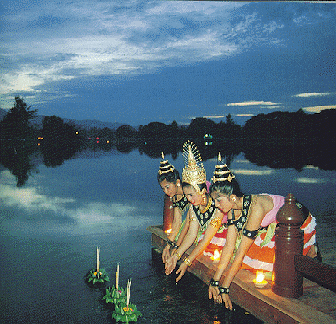 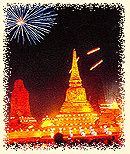 The
festival of Loy Krathong which originated in Sukhothai takes place on the
full moon of the twelfth lunar month when common floods span the Kingdom.
It is held in honour of Mae KongKa(the goddess of water) for providing
water, essential in Thai life whether for work in the fields, transport
or simply drinking. Small lotus blossom boats made out of banana leaves
filled with the traditional offerings of incense sticks, flowers and a
candle are released into canals and waterways. The modern day krathong
owes its existence to a royal lady named Nang Noppramas who designed a
krathong and presented it to the king during an early Loy Krathong celebration
in Sukhothai. Every year, Sukhothai is the site of a major gala event celebrating
the Loy Krathong festival, which includes parades and full-dress reenactions
of the Loy Krathong legend.
The
festival of Loy Krathong which originated in Sukhothai takes place on the
full moon of the twelfth lunar month when common floods span the Kingdom.
It is held in honour of Mae KongKa(the goddess of water) for providing
water, essential in Thai life whether for work in the fields, transport
or simply drinking. Small lotus blossom boats made out of banana leaves
filled with the traditional offerings of incense sticks, flowers and a
candle are released into canals and waterways. The modern day krathong
owes its existence to a royal lady named Nang Noppramas who designed a
krathong and presented it to the king during an early Loy Krathong celebration
in Sukhothai. Every year, Sukhothai is the site of a major gala event celebrating
the Loy Krathong festival, which includes parades and full-dress reenactions
of the Loy Krathong legend.
|
|









